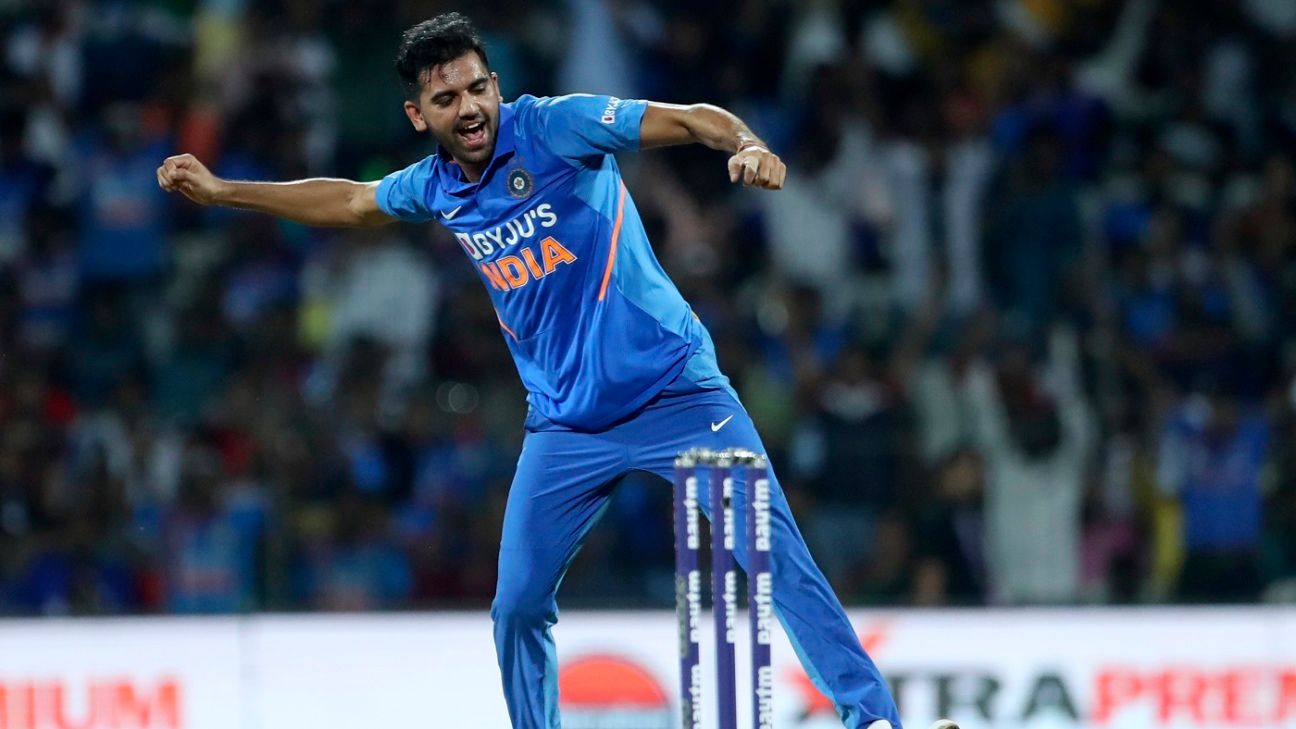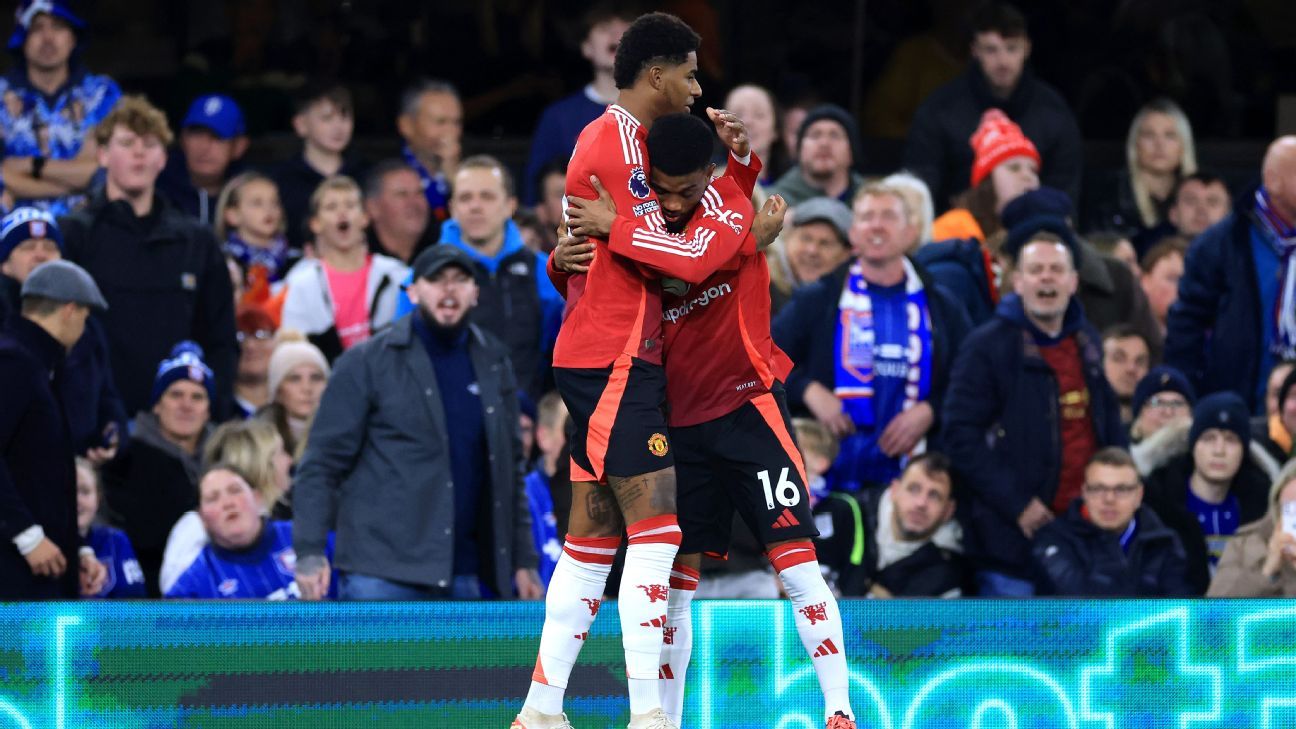
Deepak Chahar has come a long way since the memorable 8 for 10 on Ranji Trophy debut for Rajasthan in 2010-11. For all his first-class experience, it was the IPL and his powerplay spells during Chennai Super Kings' victory title-winning run in 2018 that shot him into the limelight. His ability to swing the new ball made him MS Dhoni's calling card in the powerplay.
A year on, after becoming a T20I regular, Chahar is eyeing a regular berth in India's ODI squad. With Bhuvneshwar Kumar and Jasprit Bumrah out injured, Chahar is likely to get a long run too. But he isn't thinking about that just yet and wants to just keep doing well whenever he gets a chance.
"The next six months are obviously very important," Chahar said ahead of Wednesday's second ODI against West Indies in Visakhapatnam. "All of us dream of playing for India in all formats. I was only playing T20s, and now I am playing one-dayers too, so it's great. The main focus is on fitness, I need to stay fit and play all the matches, and be available for selection for all games. I have had injuries in the past, so I'll be careful about that. That's the main focus."
When Chahar first broke through, he was largely an outswing bowler to the right-handers. Once the new ball lost its shine, he would mostly be used as a defensive option by captains. An obsession to improve his pace left him injured and effectively out of the selection radar for "four-five years" in between. He eventually took the long road up a tricky hill after stints at the MRF Pace Academy.
In 2016, Rising Pune Supergiant first signed him up when their coach Stephen Fleming was impressed with his swing bowling and lower-order hitting. While an opportunity in the starting XI didn't come, he was part of the team's plans for the future. These plans materialised when the same team management, headed by Fleming and Dhoni, signed him at Chennai Super Kings.
"I knew I had to get to 140. Since I was a child, I have tried to get to 140. That's the deadliest ball. You can play 150 on a flat pitch, but if it swings at 140, it's more difficult." Deepak Chahar on his need for speed
Chahar has only played a dozen matches for India, but he understands that to become a long-term prospect he has to work on various aspects of his bowling, which he is doing one at a time: from swing at 125kph to increased pace (high 130s), to adding new variations, to bowling to different fields. His understanding of his own game gives a peek into his mindset and to how he has evolved into a thinking cricketer, not just someone who swings the new ball and delivers overs in the powerplay.
"When I played Ranji Trophy, I focused on line and length and swing," Chahar explained. "But I struggled in between, so from there to the Indian team is a tough road. If you want to go from Ranji Trophy to the Indian team, you have to play a lot. More fitness. You have to play Duleep Trophy. It's a longer road. But since I could do well by performing in the IPL, so somewhere in between, my focus shifted to the white ball."
So how has he turned into the bowler that he is aiming to be? It's simple: by bowling at 140kph with with swing to boot. These aspects have been married to variations that he has honed over time in the nets.
"You need pace," he said. "It's tougher to swing the white ball, unlike the red ball. So many bowlers swing the ball both ways in Ranji Trophy. But it's tougher with the white ball. It's not just the shine, you need to swing the ball with your action. So I worked on that and increased my pace.
"Now I bowl the slower bouncer, and I have been working on my yorker, which has actually helped my bowling. I am confident that if someone hits me for a couple of sixes, I can york the batsman. Last year, in an IPL game in Chennai, I prepared a lot. I knew it wouldn't swing much there, so I worked on my variations. I bowl three overs in the powerplay for CSK, so you have to bowl yorkers. But you need to keep improving in cricket. Yorker, wide yorker. I try everything."
Chahar is open about his fondness for white-ball cricket, and reveals that he finds the 50-over format the hardest to adjust to.
"In T20s, the main thing is for you to save yourself," he said. "You have to bowl four overs, and you have to make sure you don't get hit. If you bowl four overs, give 24 runs and not get a wicket, that's good bowling. In Tests, you have to attack. If you give runs but pick up wickets, it's good for the team. But in one-dayers, you have to do a bit of both - pick up wickets and not give away runs.
"You have to beat the situation - what does the team demand: stop runs or get a batsman out. So one-day is more difficult than Tests and T20s. I have played a lot of one-day cricket with India A side, so that's helped. So I have an idea. I used to struggle a bit in the middle overs earlier.
"In the powerplay, you know it's two-three overs and then you have to contain the runs. And at the death, you know they will try to hit you. But in the middle overs, I couldn't do well. But I am learning. I have just played two matches internationally, so I will keep learning."
Chahar also explained how he has improved as a bowler since he first broke through in 2010-11, helped along by the understanding that swinging the ball at 125kph might not take him places.
"When I played my first season of Ranji Trophy, I used to bowl at around 125. So I struggled in between, for four-five years, I had injuries too, and that was because I was trying to increase my pace," he explained. "I knew I couldn't succeed at the top level at that pace.
"I knew I had to get to 140. Since I was a child, I have tried to get to 140 - 135-137. That's the deadliest ball. You can play 150 on a flat pitch, but if it swings at 140, it's more difficult. In between, for four-five years, when I was injured and also out of my domestic side, I changed many things. In my diet, in my action, to get more speed. You need variations too. It's become difficult too.
"For the middle overs, you have four fielders out. But I am used to bowling with two fielders out. So I get the benefit of that. In the middle overs, variations are key, and you shouldn't be predictable. You have to bowl according to your field. You need to bowl to the four fielders at the boundary. If they are trying to hit you for sixers, you want them to hit where your fielders are, so if they mistime one, you get the wicket."















 Phone: (800) 737. 6040
Phone: (800) 737. 6040 Fax: (800) 825 5558
Fax: (800) 825 5558 Website:
Website:  Email:
Email: 






